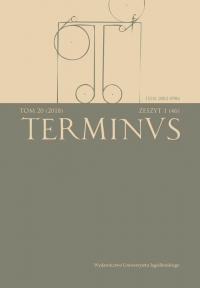Zaginiona epika kastylijska
The Lost Castilian Epic
Author(s): Rozalia SasorSubject(s): Cultural history, Social history
Published by: Wydawnictwo Uniwersytetu Jagiellońskiego
Keywords: Castilian epic; cantares de gesta; Bernardo del Carpio; Mainete; La condesa traidora; Cantar de los siete infantes de Lara; Romanz del Infant García; Cantar de Sancho II y el cerco de Zamora
Summary/Abstract: The main aim of the paper is to present the most important Castilian epic poems belonging to the so-called lost epic, i.e. anonymous texts that have not survived to our times, but one can assume with a high degree of probability that they existed, first in oral circulation, and later in prose versions in chronicle and in romancero. The existence of old Castilian epic is undermined by the individualistic theory of the origin of epic poems authored by the French researcher Joseph Bédier, who believed that there were only poems that have survived in writing, but two other theories undermine these assumptions: the neotraditional theory of the Spanish medievalist Ramón Menéndez Pidal and the eclectic theory proposed by the British hispanist Alan Deyermond. Both agree on the existence of the Castilian epic in oral tradition, with each assuming their different origin and a different number of unpreserved poems. They also agree on the causes of the disappearance of the oldest Castilian epic songs, which, even if written down, could share the fate of thousands of manuscripts destroyed due to wars, fires or normal wear and tear. Only two have survived in original versions: The Poem of the Cid in an incomplete manuscript from the first half of the 14th century and a hundred verses of the Roncesvalles (Roncevaux) poem in a manuscript also from the beginning of the 14th century. Two other epic works are known thanks to later adaptations of the texts to the requirements of the erudite epic mester de clerecía (Spanish: craft of the clergy), namely the Poema de Femán González (Poem on Femán González) and Mocedades de Rodrigo (The Youthful Actions of Rodrigo). The former comes from the mid-13th century, while the latter from the mid-14th century. Nevertheless, there is indirect evidence of the existence of old Castilian epic, including the prose versions of epic legends in medieval Latin and Castilian chronicles, as well as the occurrence of typical epic motifs in late medieval and renaissance romances, which are believed to have been created by cutting longer poems into shorter texts. The two 13th-century Latin chronicles, Chronicon mundi by Lucas de Tuy and De rebus Hispaniae by Rodrigo Jiménez de Rada, contain the richest epic material, while among the Castilian chronicles Estoria de España, commonly known under the title Primera Crónica General given by Menéndez Pidal, and Crónica de 1344, stand out in this respect. The main body of the paper is a discussion of the lost poems based on the Castilian chronicles mentioned above. The list includes only those songs whose existence is recognized by the majority of medievalists, i.e.: Bernardo del Carpio, Mainete, La condesa traidora (Treacherous Countess), Cantar de los siete infantes de Lara (Song of the Seven Lara Princes), Romanz del Infant García (A Romance about Infanta García) andCantar de Sancho II y el cerco de Zamora (Song of Sancho II and the siege of Zamora). For each text, a summary is provided along with the sources in which variants of the poems have survived, sometimes directly indicating the existence of today lost epic songs.
Journal: TERMINUS
- Issue Year: 20/2018
- Issue No: 3 (48)
- Page Range: 351-380
- Page Count: 30
- Language: Polish

